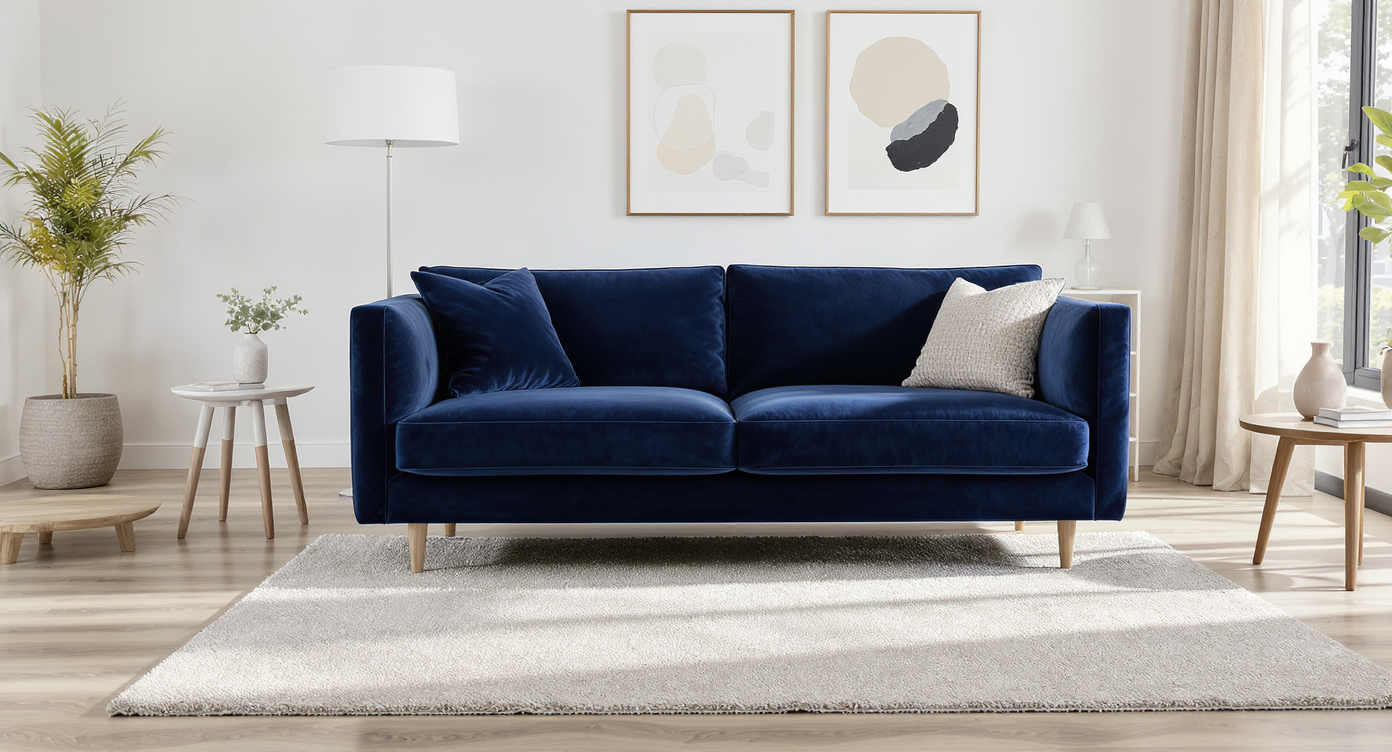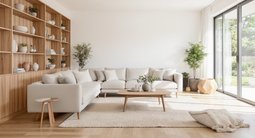TL;DR
Use this skimmable framework to nail furniture size, style, and materials. Measure first, plan clearances (30–36 in paths), then pick a primary style (70%) plus a supporting style (30%). You’ll get scale that fits, finishes that last, and a room that feels like you. Includes how to choose dining table size for 6 and a rug size guide for living rooms with a sectional.
Opening Context & Promise

Understanding traffic and use envelopes is key to harmonious furniture arrangement.
Here’s the thing: most rooms feel off because the furniture is the wrong size or crammed too close together. Style confusion comes second; scale is the silent deal-breaker. I’ve seen a gorgeous sofa make a living room feel smaller, not because it was ugly—but because it was 10 inches too deep. What most people miss is that a room has a “traffic envelope” and a “use envelope.” When you honor both with clearances and proportions, almost any style works. In this guide, you’ll get a practical furniture size guide, a simple style mix formula, and material benchmarks that survive real life (kids, pets, coffee cups). Expect hard numbers and easy decisions.
Core Question: What Furniture Fits My Room?
Leave 30–36 inches for main walkways, 18 inches of knee space at tables/desks, and keep seating sized to the wall length for comfortable layout flow.
Quick check: measure the room L×W, mark door swings, windows, radiators, and outlets, then tape out furniture footprints before buying. A 72-inch sofa felt huge in a 10×12 room until we swapped to a 65-inch apartment sofa with slim arms and gained a clear 32-inch path.
- Walkways: 30–36 in (24 in minimum in tight spots).
- Coffee table to sofa: 14–18 in.
- Sofa seat height: 17–19 in; seat depth: 20–24 in (taller people prefer 23–24 in).
- Dining: table height 28–30 in; chair seat 17–19 in; 24 in width per diner; 36 in circulation around the table.
- Bed: 24–30 in clearance on sides; nightstands within 2–3 in of mattress height.
- TV viewing distance ≈ 1.5–2.5× screen diagonal; center of screen at seated eye level.
Quotable fact: Most living rooms work best when the sofa is no longer than two-thirds of the wall it sits on.
Anecdote
A 72-inch sofa overwhelmed a 10×12 living room until we switched to a 65-inch model with slim arms, restoring a 32-inch walkway.
Style Selector: How Do I Pick a Furniture Style I’ll Still Love in 5 Years?
Choose one primary style for about 70% of the room and a 30% supporting style for contrast; this layering keeps rooms personal and timeless without clashing.
Here’s a quick decoder of major furniture styles and their signature cues:
- Mid-Century: clean lines, tapered legs, walnut/teak, tufted cushions, low profiles.
- Scandinavian/Japandi: pale woods, matte finishes, light neutrals, woven textures, simple forms, low visual weight.
- Transitional: tailored silhouettes, balanced curves and straights, neutral fabrics, understated hardware.
- Contemporary: sleek profiles, thin edges, metal accents, performance textiles, hidden hardware.
- Industrial: raw steel, distressed leather, reclaimed woods, visible joinery, rivets.
- Traditional: rolled arms, turned legs, rich woods, classic patterns, brass hardware.
- Coastal: light oak, slipcovers, linen, soft blues/sands, whitewashed finishes.
- Boho: rattan, caning, layered patterns, collected textiles, relaxed silhouettes.
Decision tip: If you love Mid-Century and Scandinavian, pair a walnut MCM sofa with a pale oak Scandi coffee table—the contrast in wood tone and leg style creates depth without noise. Quotable fact: Limiting yourself to two complementary styles beats chasing every trend, every time.
Materials & Finishes: What Holds Up and Looks Good?
Prioritize durable cores and easy-care surfaces: solid frames, resilient suspension, and performance fabrics with clear specs keep furniture looking fresh.
- Sofas: kiln-dried hardwood frames resist warping; look for sinuous or 8-way hand-tied springs. Performance fabric should test at 15,000+ double rubs (30,000+ for heavy family use). High-resiliency foam is typically 1.8–2.5 lb density.
- Tables: solid wood can be refinished; veneer is stable if the top layer is ≥0.6 mm. Protect from water rings; oil-wax finishes feel natural but need re-oiling, while lacquer resists spills.
- Rugs: wool offers resilience and cleans well; polypropylene or PET excels in spill zones; flatweaves work under doors or dining chairs. As a rule, size so front legs of seating sit on the rug.
- Metals: unlacquered brass develops patina; powder-coated steel/aluminum resists chips for indoor-outdoor pieces.
- Leather: full-grain is most durable and ages richly; top-grain balances price and look; avoid bonded leather for high-wear seating.
Quotable fact: A fabric’s double-rub count is the single fastest way to compare upholstery durability.
Room-by-Room Buying Guide
Buy anchor pieces first (sofa, dining table, bed, desk), then layer storage and accent lighting; it prevents scale mistakes and keeps budgets focused where you sit and touch most.
Living Room
Right-size the sofa to the room width, maintain 30–36 in paths, and choose arm profiles that don’t hog visual space. Nesting or C-shaped tables add surface without blocking flow.
- Sectional pitfalls: avoid chaise lengths that block doorways; keep chaise depth clear of traffic by 30 in.
- Coffee table height ≈ 16–18 in; length ~ two-thirds the sofa.
- Rug size guide for living rooms with a sectional: aim for 9×12 in a 12×15 room so all front legs sit on the rug; 8×10 often looks underscaled.
- Anecdote: In a 12×15 space, a 9×12 wool rug unified a deep L-sectional where an 8×10 made pieces float apart.
Quotable fact: Slim arms can reclaim 6–8 inches of usable seating in small living rooms.
Dining
Allow 24 in per diner and 36 in around the table; a 60–72 in rectangle seats 6, while a 48–54 in round seats 4–5 comfortably.
- How to choose dining table size for 6: target 36×72 in or a 60-in round with a pedestal for legroom.
- Round tables soften tight corners; pedestal bases maximize knee clearance.
- Rug sizing: table top plus 24 in on all sides to keep chairs on the rug when pulled out.
- Anecdote: A 42-in round pedestal saved an 8×10 dining nook—no bumped corners, eight extra inches of circulation.
Quotable fact: Standard dining height is 28–30 inches; pair with 17–19 inch seat heights.
Bedroom
Choose bed size by room: a queen fits 10×10, while a king feels balanced in 12×12 or larger—leave 24–30 in on each side for access.
- Nightstands should sit within 2–3 in of mattress height for ergonomic reach.
- Dressers need 30 in clearance to open drawers without squeezing past.
- Rug guide: for a queen, 8×10 with 24 in exposed around sides/foot; for a king, 9×12.
Quotable fact: Platform beds with inset legs visually shrink heavy rooms and ease vacuuming.
Workspace
Desk depth 24–30 in supports monitor viewing; task chairs should adjust seat height and lumbar for long sessions. Aim for 300–500 lux at the work surface.
- Keep monitor distance ≈ arm’s length; mount screens so the top third sits at eye level.
- Cable grommets and wall outlets behind the desk reduce clutter and tripping hazards.
- Anecdote: A 30-in-deep desk overwhelmed a 9×10 office; swapping to a 24-in desk plus a wall-mounted task light restored a 34-in walkway.
Quotable fact: A 24-inch-deep desk is enough for most laptops and a 27-inch monitor without neck strain.
Budget Tiers & Sourcing Strategy
Mix-and-match smartly: invest in frames and tables you touch daily; save on accent tables, decor, and easily swapped textiles.
- Entry: prioritize a solid wood coffee table, performance slipcovers, and a flatweave rug; use ready-to-assemble storage.
- Mid: upgrade to kiln-dried sofa frames, wool rugs, and solid-wood dining with veneer side pieces.
- Investment: 8-way hand-tied sofas, custom chairs, solid hardwood dining with catalyzed finish, and full-grain leather.
Online buying checklist:
- Confirm dimensions (overall, seat/arm heights, interior seating, drawer openings).
- Verify materials (wood species, veneer thickness, fabric double rubs, cushion density).
- Read return policy, freight method, and assembly steps; photograph box openings for claims.
Quotable fact: You’ll feel value longest in seat comfort and table durability—not in throw pillows.
Visualize Before You Buy
Digital mockups prevent expensive sizing and style errors by testing clearances, fabrics, and finishes on your actual room photo.
Upload a snapshot and use ReimagineHome to try sofa sizes, dining table shapes, rug layouts, and mixed wood tones in minutes: https://www.reimaginehome.ai/?utm_source=blog.
Visualization Scenario
Uploading a photo of a 12×15 living room to ReimagineHome to test a 9×12 rug vs 8×10 and swap between Mid-Century and Scandinavian coffee tables before buying.
FAQ
How do I choose the right sofa size for my living room?
Measure wall length and leave 30–36 in for walkways; most sofas should be no longer than two-thirds of the wall. Keep 14–18 in between sofa and coffee table for reachability.
What’s the best dining table size for 4, 6, or 8 people?
Plan 24 in per diner. For 4: 36–42 in round or 30×48 in rectangle; for 6: 36×72 in rectangle or 60 in round; for 8: 42×84 in rectangle or 72 in oval.
Which furniture styles mix well without clashing?
Use a 70/30 mix: pick one primary style, then add a supportive style that contrasts in texture or tone (e.g., Mid-Century sofa with Scandinavian tables). Keep finishes to 2–3 wood tones.
What rug size works with a sectional sofa?
In a 12×15 room, a 9×12 typically grounds an L-sectional so all front legs sit on the rug. Avoid rugs where the sectional corner touches but chairs float.
How do I compare performance fabric vs natural linen?
Performance fabrics list double rubs (15,000–30,000+) and stain resistance; linen wins on breathability and patina but wrinkles and can abrade faster. For kids/pets, choose performance.
What clearance do I need around a bed and dresser?
Leave 24–30 in on bed sides and 30 in in front of dressers for drawers. Nightstands should be within 2–3 in of mattress height for ergonomic reach.
Closing Section
Comfort, longevity, and joy come from choosing fewer, better pieces sized to your space and finished for real life. Measure honestly, respect clearances, and commit to a primary style with a supportive second so your rooms feel layered—not loud. When you anchor with durable frames, right-height tables, and the correct rug size, everything else—color, art, lighting—falls into place. Before you click buy, test ideas digitally. Drop a photo of your room into ReimagineHome to preview sofa depth, dining table size for 6 or 8, and mixed finishes in seconds, then order with confidence. Explore it here: https://www.reimaginehome.ai/?utm_source=blog.
.svg)

.svg)







.png)